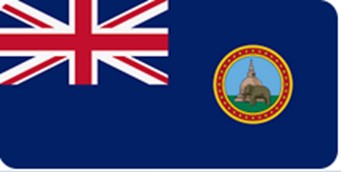British Ceylon Flag Correctly Recognized the True Identity (Sinhala Buddhist Only) of Sri Lanka
Posted on July 26th, 2025
Dilrook Kannangara

One of the best kept secrets from school and media history is the British Ceylon Flag. It’s so secretive that only a very few even know about it. British Ceylon flag mercilessly slays many myths including the myth of Tamil homeland. It is a brutal reality that Tamils and how they were referred to before 1911 had no connection whatsoever with the island nation even until 1948. What’s most striking is all Tamils accepted it without any complaint.
This is the British Ceylon flag from 1875 to 1948. It has the Union Jack on the left side corner which was and still is very common in a number of British territories. Nothing special about Ceylon in that regard. What is unique about Ceylon is the Sinhala Buddhist pagoda (stupa) and the elephant close by. The type of pagoda (stupa) depicted on the flag is uniquely Sinhala Buddhist. The structure and the shape are atypical of a Sinhala Buddhist construction. Similar constructions are found around the island numbering thousands. The elephant is no accident. Elephants were and still are associated with Sinhala Buddhist shrines and their processions. UNESCO World Heritage Kandyan Perahera is a case in point.
What about the lion with the sword? British rulers would not allow it as it is the same flag used by sections of the British monarchy. Leaving it out is understandable.
What about Tamils, Muslims and Christians? The British did not consider them to be associated with the island nation for factual reasons. While Sinhala Christians were once Buddhists, they too can claim to be associated with Sinhala Buddhists until incentives by the Portuguese, the Dutch and the British motivated them to change only their religion while maintaining their ethnic Sinhala identity.
All Tamils and Muslims accepted this Sinhala Buddhist only flag without any complaint. None of them raised their resentment, disagreement or disapproval. In doing so they accepted the fact that the entire island nation had only a Sinhala Buddhist identity.
These facts clearly bust Tamil homeland clams. In fact, this settles many a debate about who came first and divisions said to have existed within the island. The entire island had one and only one identity even the British were compelled to accept and that was its Sinhala Buddhist identity.
After Independence in 1948 the flag underwent a number of changes. The main change was the addition of Indian stripes to the left of the flag. These stripes were taken from the Indian flag to represent Hindus and Muslims – just as in the Indian flag. However, the Dharma Chakra” in the Indian flag was maliciously omitted. As the Indian flag was used as a guide to bring parts of it, the Dharma Chakra” should also have been added within the amber and green strips on Sri Lanka’s flag.
Successive Sinhala government deliberately hid this flag from the people since 1948 in order not to hurt the sentiments of Tamils and Muslims. It was done in good faith. However, this good gesture was not reciprocated by Tamil and Muslim elected politicians, civil activists and other community activists. They considered it a sign of weakness. Hence this reminder. Unlike the British Ceylon flag, the Sri Lankan flag is inclusive but not necessarily connected to historical facts of the island. It’s a flag of a new nation created only in 1972 separated from its historical roots.